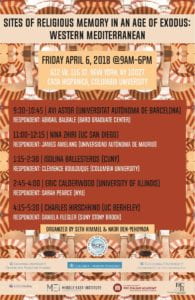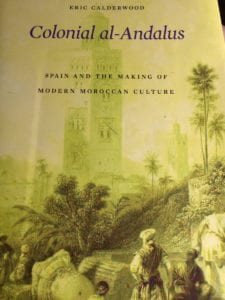
 This is a lightly edited version of the comments that I made following Eric Calderwood’s talk at the Colubmia Workshop “Sites of Religious Memory in an Age of Exodus: The Western Mediterranean.” Part of the reason I’m posting my response is precisely because it is dependent upon reading his new book, Colonial al-Andalus, which I want to encourage. There are many people in medieval studies — especially those who are convinced that there is only one correct way to care about race, nation, and colonialism’s impacts upon the field and that people who work on Spain and North Africa and their modern-medieval legacies Don’t Do It Right ™ or at all — who would benefit tremendously from it. It’s also just fabulous and fascinating. So, go read the book and then come back to this as a response to chapter 6:
This is a lightly edited version of the comments that I made following Eric Calderwood’s talk at the Colubmia Workshop “Sites of Religious Memory in an Age of Exodus: The Western Mediterranean.” Part of the reason I’m posting my response is precisely because it is dependent upon reading his new book, Colonial al-Andalus, which I want to encourage. There are many people in medieval studies — especially those who are convinced that there is only one correct way to care about race, nation, and colonialism’s impacts upon the field and that people who work on Spain and North Africa and their modern-medieval legacies Don’t Do It Right ™ or at all — who would benefit tremendously from it. It’s also just fabulous and fascinating. So, go read the book and then come back to this as a response to chapter 6:
***
Speaking in New York City about the use of al-Andalus as a site of memory in the creation of both a colonial and later an independent Morocco mediated by the visual vernacular of its architecture, it is almost impossible to avoid thinking about the reinstallation of the Islamic galleries at the Metropolitan Museum of Art and the especially the creation of the Moroccan Court in 2011 and the ways in which the museum presented and justified the project. For those who don’t know the background: following upon the last major overhaul of its Islamic galleries in the 1970s which showed a real drive, innovative at the time, toward displaying Islamic art not as craft but as art on a par with the European objects in the collection, the Met, in the 8-year reimagining of the galleries culminating in 2011, moved its presentation of the artworks more towards accessibility, relevance, and cultural-historical contextualization. One of the centerpieces was the creation, de novo, of a Moroccan courtyard by Moroccan artists, designers, and craftsmen, with consultation from curators and architectural/landscape historians on staff at the museum. This followed the museum’s precedent of the creation of a Ming Dynasty-style garden court when the East Asia galleries where revamped in the early 1980s.
A mini-documentary on the museum’s web site records some of the processes of creation; and in rewatching it after reading Eric’s chapter, what really jumped out was the way in which the curatorial thinking about what constitutes Moroccan architecture was very much informed by the Moroccan nationalist appropriation of the colonial/fascist discourse about being the site and the heritor and continuation of Andalusi cultural heritage.
To highlight some examples:
- The major narrative voice in the documentary is that of Najima Haider, who is one of the associate curators of Islamic art, who begins describing the design process as “medieval-style courtyard.”
- In the course of talking about the mathematics of scaling down a full-scale, three-story Moroccan courtyard for the one-story space available in the museum, there’s a discussion of the different kind of CAD programs they used, until finally the landscape designer Achva Stein actually physically cut out little pieces of paper in the shape of tiles to stick on the walls which she described as a “medieval solution” to a neo-medieval problem. So she’s not only using “medieval” to mean backwards, but also to connect the idea of the medieval to the artisanal.
- Not so much Tetouan, but Fez and Granada are treated as one cultural unit throughout the little documentary and, presumably, throughout the thought process that created the space. Not only are there explicit invocations of the Alhambra as a model for this Moroccan courtyard, but it is also a clear that those references come from the scholarship produced for the 1992 Al-Andalus exhibition at the Met. In his ArtForum review of the exhibition, Nasser Rabbat takes on this view.
- (contrast with the Kevorkian room, Syrian colonial context)
- One of the heads of the Naji family studio, which carried out the work, said: “We were transported back to the year 1300.”
- There’s a question of authenticity: Haider talks about authenticity vs. reproduction; in other words that they are not trying to reproduce a real courtyard, but still want it to feel authentic. She also refers to the tiles as being done in 14th and 15th-century colors, while Naji talks about artificially aging them so that they look as they would now if they were from that period.
The New York-based echoes of the historical movement(s) that Eric has identified are fairly self-evident. This is al-Andalus mediated through Morocco, it is the Middle Ages mediated through Moroccan craftsmen, it is the elevation of the urban environment. But one theme that struck me both in Eric’s analysis of how this kind of narrative unfolded and the way in which it’s picked up by the Met staff was that of authenticity.
Three examples of where the idea of authenticity occurs in the chapter are:
- p. 217: On Santos Fernández reporting on the Ibero-American Exhibition in 1929: “The official Morocco Pavilion gave Fernández ‘a strong impression of Moroccan authenticity.’”
- p. 220: “The Spanish, in contrast [to the French] saw Andalusi culture as the essential and authentic core of Moroccan culture, and they imagined themselves as the direct descendants of al-Andalus .”
- p. 221: “When Bertuchi spoke of the revival of Moroccan art under Spanish colonialism, he was talking about the revival of an artistic tradition that was not only authentically Moroccan but also authentically Spanish.”
What I want to do by highlighting these short citations and the same terminology that occurs when the Met curator talk about the Moroccan courtyard is to raise the question of how the different players on this stage understand the question of authenticity, the axes of authenticity, and of how that understanding is bequeathed, very implicitly, going forward. In other words, it’s not just a simple question of what authenticity means and then of what is authentic in terms of historicity and geography, but also of what a kind of joint Spanish-Moroccan authenticity might imply.
In the study of medieval Spain and North Africa, it has become increasingly clear, especially in the last 15-20 years to many practitioners that historical and literary scholarship need to see the Maghreb as an integral cultural unit rather than as two spaces divided by traditional Ango-American views of what constitutes nations in Europe and where a hard break between Europe and Africa occurs. But at the same time, what Eric has shown is the very pernicious side of that kind of unitary thinking. And so this raises two questions in moving forward: How do we account for this impulse in medieval scholarship? And to how we can look at the region in a unitary way without replicating the violence of the colonial project that was so contingent upon the very continuity that we are currently viewing as desirable and necessary?
***
Postscript: I left this final paragraph out of my comments at the workshop because I didn’t want to pull my remarks in too many different directions and because this was really ultimately more of a response to the status quo of #medievaltwitter than to anything that was happening in the conference — mercifully there is still a world of thought offline! — but this was another issue that came up in formulating my thoughts about the book.
I think that it’s worth mentioning that many areas of medieval studies are — very much to their benefit — beginning to appreciate this kind of historiographic work that clarifies where some of the modern understandings of places and cultures that are often attributed to the Middle Ages in fact come into being in the modern period. It’s in part a natural element of the field to know its own history, and in part it’s being accelerated by very contemporary repurposing of medieval tropes such as Crusades and Vikings on the extreme right to justify all kinds of contemptible, hateful modern attitudes. Medievalist responses have very much been drawn down black-and-white lines. Even as in my own historiographic research right now, I’m reading a book of poetry by Manuel Machado that is basically a paean to Franco that casts him as a medieval Christian reconquerer no less than Fernando el Católico or the Cid; and so while I knew that Franco had tried to be a bit sensitive about covering up figures of Santiago Matamoros when he met with his Moroccan generals, I was really surprised to learn about the extent of Francoist engagement with and promotion of Islam. It’s a historiography that doesn’t fall along the neat lines of other European historiographies, where the various fascist forces uniquely adopted the Christian Middle Ages to imagine their histories. With that said, I’ll just leave off with a final question: To what extent is this a case of “España es diferente” and to what extent should we see it as a call to reexamine the one-dimensional nature of the current discourse on the relationship between medievalism in general and mid-century fascism?
